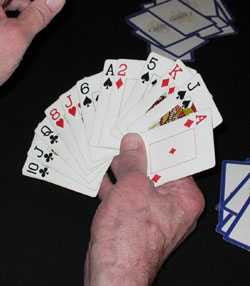Bridge takes prof far

Hands like this are being played for prizes all around the world.
Barbara Black
Boris Baran spent part of spring break playing bridge in Iceland — top-flight competitive bridge.
Baran, who has taught computer information systems in the JMSB for 25 years, is a “grand life master” in a card game played by hundreds of thousands of people around the world.
Contract bridge, usually just called bridge, is such a richly absorbing pastime that it brings people together (and sometimes drives them apart). It can keep people up for hours. It probably keeps Alzheimer’s at bay.
Much as it saddens Baran to admit it, you no longer see students playing bridge on a university campus. That’s where most bridge players got their start.
“In those days, there were no computers, and no internet. We had a lot of time on our hands,” Baran recalled in a phone interview just before he took off for Reykjavik.
“When I was at McGill, I played hearts for money. I won so much nobody would play with me. So I started watching people playing bridge. One day they asked me to sit in, and the rest is history.”
Baran has played games all over the world. “This is my third time at the tournament in Iceland. When you’re invited, they cover all your expenses. I’ve been to China three times and to Europe 10 to 15 times. I’ve played all over North America, including Las Vegas. A professional bridge player can travel 52 weeks a year.”
It’s not the prize money that interests him. The prize in the Iceland tournament is only $5,000. It’s the love of the game, a passion shared with thousands who love the combination of skill, logic and luck, the endless possibilities, the intellectual challenge.
Like others of his calibre, Baran has a nice sideline playing with wealthy people; he didn’t say whom. Bill Gates, Warren Buffett and lesser billionaires and millionaires love playing bridge so much they pay top players to play with them.
Bridge is played with two sets of partners sitting opposite each other at a table. The pack of cards is dealt, and the players start by bidding, or stating how many tricks, or rounds of cards, they will win; that’s the contract. Then the play begins, with one player’s cards displayed face up on the table (called the “dummy”). At the end of the play, the tricks are counted in the form of a score. Bridge can be played in tournaments, with many players, which makes it an enormously popular pastime.
“The game has evolved dramatically,” Baran said. “You have to be armed with all the bidding conventions and treatments that have developed over the years, and be ready to play against your opponents’ system, too.”
He’s excited by the possibilities opened up by online bridge. A friend of his developed a popular software program called Bridge Basic Online. Baran says that because the bridge vocabulary is so minimal, people can play one another around the world without speaking the same language.
Baran’s partner of many years, Mark Molson, died suddenly on a golf course in January 2006. He was only 56. They had played in many championship tournaments together, and were considered Canada’s foremost bridge partnership. They won the world championship in 2002. Fittingly, it was played in Montreal.
Molson’s obituary in the Globe and Mail said top class bridge is not a game you learn by reading books or taking lessons, but by practice.
“It takes 10 years of dedicated play to reach the level of mediocrity in bridge,” Baran told the Globe. “Once players reach that level, most of them seldom get any better.”